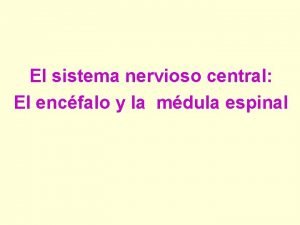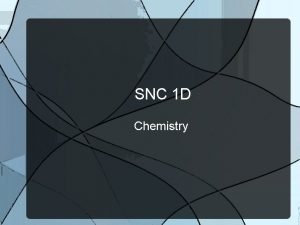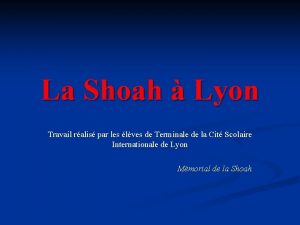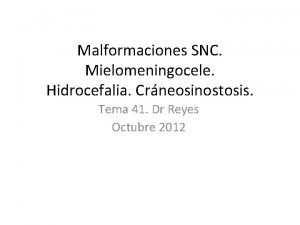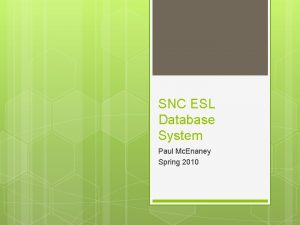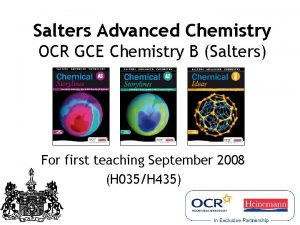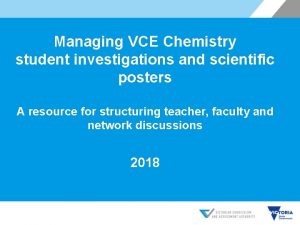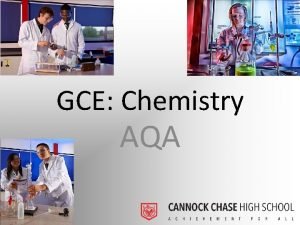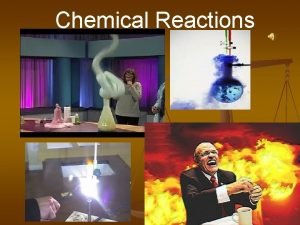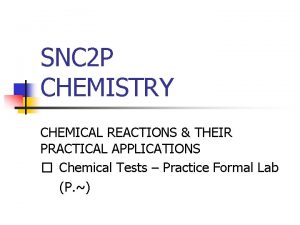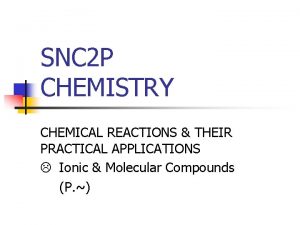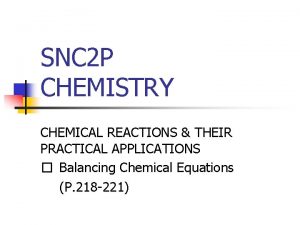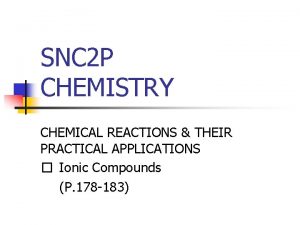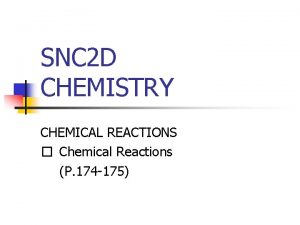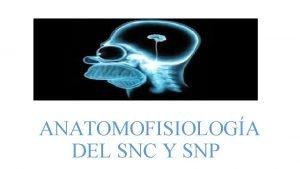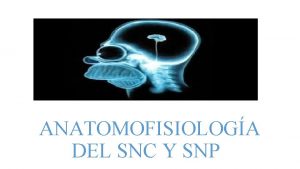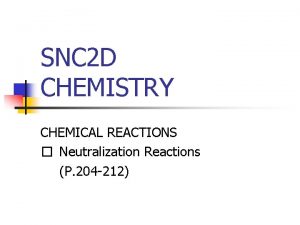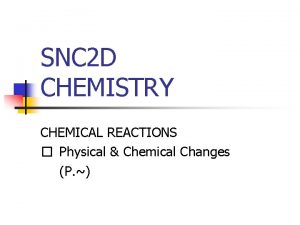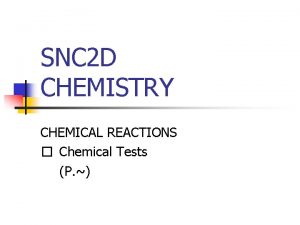SNC 2 P CHEMISTRY CHEMICAL REACTIONS THEIR PRACTICAL






















- Slides: 22

SNC 2 P CHEMISTRY CHEMICAL REACTIONS & THEIR PRACTICAL APPLICATIONS Introduction (P. 154 -157)

Aspirin and Heroin Got a headache? Like millions of other pain sufferers around the world, you may turn to Aspirin for quick relief. Surprisingly, Aspirin was first made using the same chemical reaction that produced heroin – a highly addictive and illegal narcotic. January 16, 2022 2 PCHEM - Introduction 1

Aspirin and Heroin The Bayer drug company first made Aspirin in the 1890 s, but officials initially ignored the new product. In 1898, Bayer chemists used the same reaction on morphine, a wellknown pain reliever at the time. Tests on the new product were impressive: it was a good pain reliever and an even better cough remedy. Plus it made the patient feel wonderful! January 16, 2022 2 PCHEM - Introduction 2

Aspirin and Heroin Soon, a new Bayer cough syrup called “Heroin” was in drug stores around the world. Shortly thereafter, reports about heroin addiction began to appear. Public pressure forced Bayer to stop producing their heroin-laced cough syrup in 1913. NOTE! Heroin medications are no longer available. Bayer eventually recognized Aspirin’s potential, and it is now widely used around the world as a painkiller. January 16, 2022 2 PCHEM - Introduction 3

Aspirin and Heroin The history of Aspirin and heroin teaches us the importance of thoroughly testing a new product before making it available. It also shows how the chemicals we produce through chemical reactions can have both costs and benefits. January 16, 2022 2 PCHEM - Introduction 4

Overall Expectations By the end of this course, students will: 1. Analyze how chemical reactions are employed in common products and processes, and assess the safety and environmental hazards associated with them; 2. Investigate, through inquiry, the characteristics of simple chemical reactions; 3. Demonstrate an understanding of simple chemical reactions and the language and ways to represent them. January 16, 2022 2 PCHEM - Introduction 5

Big Ideas Concepts that students should retain long after this course are: < Chemicals react with each other in predictable ways. < Chemical reactions are a necessary component of chemical products and processes used in the home and workplace. January 16, 2022 2 PCHEM - Introduction 6

Getting Started: Useful Concepts & Skills CONCEPTS REVIEW 1. Refer to the three diagrams below to answer the following: (a) Explain why the substances are mixtures. January 16, 2022 2 PCHEM - Introduction 7

Getting Started: Useful Concepts & Skills CONCEPTS REVIEW 1. Refer to the three diagrams below to answer the following: (b) Which mixture appears different from the other two? Why? January 16, 2022 2 PCHEM - Introduction 8

Getting Started: Useful Concepts & Skills CONCEPTS REVIEW 1. Refer to the three diagrams below to answer the following: (c) Classify each of the mixtures as being either heterogeneous or homogeneous. January 16, 2022 2 PCHEM - Introduction 9

Getting Started: Useful Concepts & Skills CONCEPTS REVIEW 2. Refer to four diagrams below to answer the following. (a) Which diagrams represent pure substances and which represent mixtures? Why? January 16, 2022 2 PCHEM - Introduction 10

Getting Started: Useful Concepts & Skills CONCEPTS REVIEW 2. Refer to four diagrams below to answer the following. (b) Which diagram shows only atoms of one element? January 16, 2022 2 PCHEM - Introduction 11

Getting Started: Useful Concepts & Skills CONCEPTS REVIEW 2. Refer to four diagrams below to answer the following. (c) Which diagram shows only molecules of one element? January 16, 2022 2 PCHEM - Introduction 12

Getting Started: Useful Concepts & Skills CONCEPTS REVIEW 2. Refer to four diagrams below to answer the following. (d) Which diagram shows only molecules of a compound? January 16, 2022 2 PCHEM - Introduction 13

Getting Started: Useful Concepts & Skills CONCEPTS REVIEW 2. Refer to four diagrams below to answer the following. (e) Which diagram could represent carbon monoxide, CO? January 16, 2022 2 PCHEM - Introduction 14

Getting Started: Useful Concepts & Skills CONCEPTS REVIEW 3. In your notebook, write the chemical formula (selected from the list on the right) of each of these substances. (a) hydrogen H 2 O (b) carbon dioxide Na. Cl (c) table salt CO 2 (d) hydrogen peroxide H 2 (e) water O 2 (f) oxygen H 2 O 2 January 16, 2022 2 PCHEM - Introduction 15

Getting Started: Useful Concepts & Skills CONCEPTS REVIEW 4. Draw Bohr-Rutherford (B-R) diagrams to represent the following atoms: (a) lithium (b) carbon (c) chlorine (d) argon January 16, 2022 2 PCHEM - Introduction 16

Getting Started: Useful Concepts & Skills CONCEPTS REVIEW 5. (a) What fundamental particle inside the atom is responsible for the “hair-raising experience” shown below? (b) Compare three fundamental particles in an atom with respect to size, mass, charge, and location. January 16, 2022 2 PCHEM - Introduction 17

Getting Started: Useful Concepts & Skills SKILLS REVIEW 6. Briefly describe how you would investigate the following properties of substances in the lab. (a) the boiling point of water (b) the solubility of different solids in water (c) the gas produced when magnesium reacts with hydrochloric acid (d) the reactivity of the elements lithium and sodium with water January 16, 2022 2 PCHEM - Introduction 18

Getting Started: Useful Concepts & Skills SKILLS REVIEW 7. Suggest two tests that you would use to classify the elements below as metals or non-metals. Explain your choices. January 16, 2022 2 PCHEM - Introduction 19

Getting Started: Useful Concepts & Skills SKILLS REVIEW 8. The following diagram shows two students performing an experiment in the lab. Find at least five lab safety errors. January 16, 2022 2 PCHEM - Introduction 20

Getting Started: Useful Concepts & Skills TEXTBOOK P. 157 Q. 1 -6 January 16, 2022 2 PCHEM - Introduction 21
 Section 2 classifying chemical reactions worksheet answers
Section 2 classifying chemical reactions worksheet answers Section 2 reinforcement classifying chemical reactions
Section 2 reinforcement classifying chemical reactions Chemistry unit 5 reactions balancing reactions worksheet
Chemistry unit 5 reactions balancing reactions worksheet Chemical reactions section 3 reactions in aqueous solutions
Chemical reactions section 3 reactions in aqueous solutions Chapter 8 review describing chemical reactions
Chapter 8 review describing chemical reactions Chemistry in biology section 2 chemical reactions
Chemistry in biology section 2 chemical reactions Chapter 6 section 1 atoms elements and compounds answer key
Chapter 6 section 1 atoms elements and compounds answer key Section 1 chemical changes
Section 1 chemical changes Chapter 18 chemical reactions balancing chemical equations
Chapter 18 chemical reactions balancing chemical equations Hhps octagon meaning
Hhps octagon meaning Rombencefalo
Rombencefalo Snc1d chemistry
Snc1d chemistry Snc lajaa venissieux
Snc lajaa venissieux Snc società
Snc società Snc
Snc Paul mcenaney
Paul mcenaney Redox reactions examples
Redox reactions examples Salters advanced chemistry
Salters advanced chemistry Vce chemistry scientific poster
Vce chemistry scientific poster Ccea gce chemistry practical support
Ccea gce chemistry practical support Types of reactions chemistry
Types of reactions chemistry 5 types of reactions in chemistry
5 types of reactions in chemistry Type of reactions chemistry
Type of reactions chemistry










